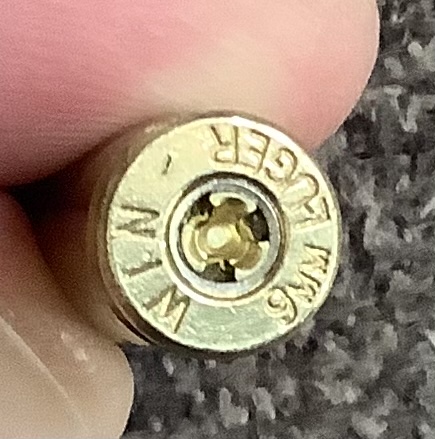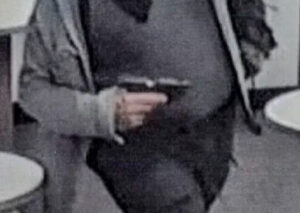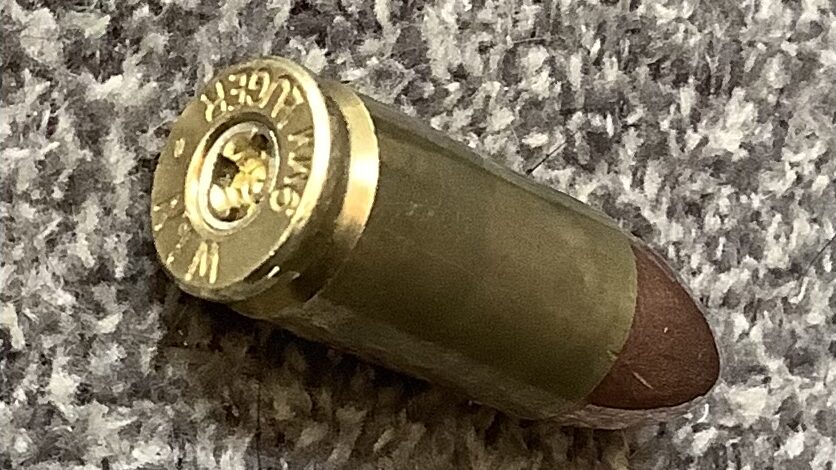I encountered this dud round in the middle of a shooting competition at the range recently. Even though it’s from one of those bottom feeders—Eek!—it provides a good opportunity to make a few observations that are universal in nature, and not related to any particular weapon type.
What happened?
As you can see from the lead image, the round is a 9mm cartridge with a primer that’s installed backwards. This round was not factory-new, but had been reloaded by a commercial reloading outfit that sells remanufactured ammo in bulk.

I attempted to fire this cartridge on a stage where the shooter was required to draw and shoot an 8″ steel plate at a distance of 15 yards, obtaining a single hit. At the sound of the timer, I drew from concealment, aligned the sights, and pulled the trigger on my pistol, only to get the dreaded “click.” I moved right into performing Immediate Action (“Tap, Rack”) and was able to hit the target with the next shot, stopping the timer at just under twice the average stage time—not bad, considering, but certainly not good, if I’d been making this shot for real, to save my skin.
Thoughts
-
Quality Control. When there’s a lot of stress on the system, quality control can take a hit. Ammunition manufacturers are struggling to keep up with record-breaking demand right now, and running their equipment and people hard. In an environment like this, it’s not uncommon to see an increased number of manufacturing mistakes like this one. In fact, I’ve seen several mistakes like these over the years, especially during past ammunition crises, so it pays dividends to inspect your ammunition closely. Even the best manufacturers will accidentally let a round like this slip out the door from time to time, and I’m seeing them with increasing frequency in the present situation.
- Pay attention. In this case, I was loading from an ammo can full of loose rounds, and I simply scooped up a handful and stuffed them into magazines without inspecting each round closely. It’s easy (yet still not advisable) to get into that mode during high volume training or a match, but I strongly encourage you to pay close attention when you’re loading your gun for duty. Take the time to do a thorough inspection of your duty ammo, before it goes into your defensive gun. Check each round for defects, shake it to verify there’s a powder charge (better yet, weigh it with an appropriate scale), and test its fit in the chamber(s) of your gun. Consider it a cheap form of life insurance.
Immediate Action. While I deserved an “F” for my lack of attention to detail in preparing magazines, I was pleased with how quickly I fixed the problem. Once I got that “click,” I immediately went into my “Tap, Rack” without undue delay. One of the ways that I’ve heard “Immediate Action” expressed is to call it a “non-diagnostic clearance,” and I like that expression because it conveys what we want. The objective is not to pause and diagnose the exact nature of your stoppage, but to immediately perform the action that is most likely to clear it (your “Tap, Rack”), once you get the proper stimulus (the “click”). No detailed investigation or analysis is required here, just react to the “click” with your “Tap, Rack” and attempt to fire again. If that doesn’t work, then we go down another branch of the tree to remediate.
I’ve been diligent about training this over the years, and I was glad that I did everything on autopilot when I encountered this unexpected stoppage. It was a good testament to my training, even if it didn’t say much about my attention to detail when preparing magazines.
Note that the nature of your non-diagnostic action will vary depending on your weapon. Our response to a failure to fire is different in an autopistol than it is in a revolver or pump shotgun. If you work with multiple types of firearms, make sure you put in the reps to program the right response with each type. It won’t do you any good to reflexively tap the bottom of your revolver grip!
-
Revolver Advantages. This event brings us back to a point we’ve discussed here before: It’s one of the revolver’s greatest advantages that it doesn’t rely on the ignition of the cartridge to operate the gun’s mechanism. If I’d been shooting my revolver instead of my auto, I wouldn’t have been required to spend as much time fixing the problem before firing again. A simple pull of the trigger would have solved my problem, in much less time.
Every gun represents a compromise of some sort, and we have to take the bad with the good. There’s a lot of folks out there who disfavor the revolver because of its (comparatively) low capacity, but it’s only fair to note this disadvantage is offset by other benefits.
Consider, if you will, how this scenario might have turned out different for me, if I’d been engaged in a close-contact battle with an opponent. Is it possible that I may not have had the space, time, or ability to clear this stoppage and resume firing? Would it be an advantage to be able to make the weapon fire again simply by pulling the trigger a second time?

Trainer Greg Ellifritz has previously documented how auto stoppages are relatively common in real-world encounters, when stress, chance and Murphy take their toll. While we recognize the substantial benefits offered by autos, it’s important to understand their weaknesses as well, and consider what we can do to mitigate their effects. Certainly, part of that is to conduct appropriate, high quality training, like the training that helped me to recover from my mistake during the match.
There are equipment issues to consider as well, though. Could it be that the revolver isn’t “dead” after all, and there’s a still a good case for it in the polymer age?
Sometimes there’s a lot that can be learned from a simple mistake in training.


Many moons ago I encountered a factory dud .45 ACP round. The primer went off, backing the slide out of battery, but nothing else. I pulled the round and it was in tact – except there was no flash hole in the primer pocket. OOooopsie !! Fortunately, this was in practice. Unfortunately, it can rear its ugly head when least needed.
Mike is right in that the revolver is far from dead, not even close to being ill when it comes to being a viable defense platform. Just look at S&W J-frame production numbers.
As much as I’ve had to rely on bottom feeders in my career, a S&W J frame rode nicely in my front pants pocket. Which one do I have more faith in ? Do you have to ask ? : – }
Indeed. The Achilles heel of the autoloader is that the ammo is part of the operating system!
Ammo problems can still tie up a revolver, but at least they don’t depend on the ammo to cycle.
Same for me. The department says I have to carry my bottom feeder gun. My backup is in my front left pants pocket- a 442. That’s also my usual ccw gun but when it has to be really tiny, I go to a NAA folding grip 22 mag. For court, I strap on a 2020 python on under my suit coat. I’ve officially taken over the nickname “the revolver guy”(given by the range masters)
In an ancient episode of “Have Gun, Will Travel” Paladin buys a box of .45 Colt for his SAA and he looks over each cartridge before he inserts them into the cylinder. I probably saw that episode 50 years ago and I’ve never forgotten what Paladin did. Whether it’s for my revolvers or my auto loaders I look at each cartridge for primer, crimp, and general condition. This served me well in competition and will also serve me well if bad things happen.
TV actually got it right, for a change!
You can always tell when a gun guy (maybe an armorer, maybe a tech advisor) has an input to the acting. Sometimes it’s subtle, like your Paladin scene, or when when Tuco sniffed the parts of the guns he had disassembled in “The Good, The Bad, and the Ugly.”
Hey Mike,
As a relative whipper-snapped compared to other more knowledgeable members here, I’m drawing a blank on this one. Why would you need to sniff the disassembled pieces of a gun?
Adam, one of the components in black powder is sulphur, and a gun that has been fired, but not properly cleaned, will have that “rotten egg” smell of sulphur. When Tuco did his sniff check, he was evaluating how well the guns had been maintained!
Tuco (disgusted): Revolvers.
Shop keeper: Yes, revolvers.
; ^ )
A true classic!
Back when I was a copper we transitioned to S&W 9mm’s from our Ruger Security Sixes in 1991. A couple years later I was at the annual qualification and got a double feed during the shooting while moving portion. They had told us these was quite rare. (This was the first semi-auto I had ever shot) It took me a second to figure out what it was but no worries because the firearms instructor next to me started literally screaming at me, “double feed, double feed, what the f@$k are you going to do?” I dropped the paperweight, drew my S&W .38 Bodyguard from my ankle holster and finished the exercise (thankfully there were only a couple rounds left). Well, this guy just about hugged me he was so excited lol. Revolver for the win!
YES! That’s the BEST kind of Immediate Action, right there! Bravo, Sir!
Smart move, RetDet. As Tuco would ad lib in The Good, The Bad, and The Ugly:
“When you gotta shoot – SHOOT, don’t talk !”
Pump-action shotgun shells required special attention.
It happened to me: when inspected the shells removed from the magazine, I discovered that were deformed by the magazine spring tension. The shells were widened in the center, walls aparted from the wad. The star crimp was also a bit opened.
The gunpowder passed through the wad and mixed with the shot. Some grains were leaking by the star crimp opening.
I’ve seen that before too, Erick. The first clue was having traces of plastic buffer everywhere, after it leaked out.
Good to know, I’ll make sure to watch out for that in future. I’ve been told that shotgun shells in box magazines get deformed fairly often as the shells were designed for standard tube mags, not to handle the forces from mag springs below and feed lips above in a box mag.
Snublord,
While that makes sense, you can also wear out shot shells in a tube magazine. Stay careful!
A friend had ignition problems on reloaded ammo, and requested my help.
He used the same lot of primers and gunpowder to reload .380 Auto and .38 Special ammo. The revolver – a brand new Taurus 889 – misfired many times, while the pistol – a Imbel .380 GC – fired all rounds flawlessly.
At the first moment, we think that the revolver was with malfunction. But factory ammo worked perfectly.
British autor Col. John Weeks compared S&W Victory model with Enfield revolvers. Enfields are less accurate due its heavy trigger pull, but always fired, while the smooth action of S&W was not reliable for wartime ammo.
The problem – later detected with a micrometer – was the primer cup, shorter than standard measure. The pistol, with its longer firing pin, pushed the primer into the pocket and fire it. The shorter revolver firing pin can´t do it.
Imbel pistols – even in .380 Auto – are Mil-Spec guns, made to fire even poor quality, wartime-made ammo. The Taurus 889 is a superb gun, but is still a sporting weapon.
Lesson learned: sporting and combat guns has different specifications. No sportsman runs a match with bad ammo, while a combat weapon must be a ostrich.
Amen, Erick. I had a similar conversation recently with a shooter who was showing me the extremely light trigger pull on his gun, which he had modified. I warned him that he was dancing on the edge of unreliability after these modifications. I hope he doesn’t find out that I’m right the hard way, as he carries this gun for defense.
What a waste of a precious small pistol primer!!
Oddly I have had more bad factory revolver ammo over my 19 years of shooting than auto ammo (excluding rimfire). Raised primers and slugs jumping their light crimp are the most common.
Haha! It IS kind of sad, isn’t it Tim? That’s probably a Dollar sitting there in that photo!
LOL, yeah around here we have suspect ammo reloads selling mixed brass 9mm with small rifle primers for $1.10 a round.
It’s interesting, with the rise of body-cam videos, how more frequently we see malfunctions in police officer involved shootings. Granted, it doesn’t happen a majority of the time, but it’s certainly not as rare as I’d been led to believe previously.
As a regular civilian who’s most likely need for a gun defensively would probably be very sudden, unexpected, under an enormous amount of stress, and maybe without a proper shooting grip or stance, a revolver makes more and more sense for me. Getting that second or third shot off very quickly with the highest level of reliability seems a lot more important than the 14th or 15th shot.
Joe, I had many video links to choose from that illustrated this fact. I just decided to use the most recent one, from the hospital shooting, but I had another 4 or 5 that I could have used. You’re right—this seems to happen more often than we would think.
100% agree brother. I still love my Glocks, but I seem to reach for a revolver more and more often.
Civilian shootings “tend” to happen at close range, if not contact range.
I feel comfortable with quality revolver, a reload (just so I won’t be standing around with gun, not that I’ll actually reload in a fight) a Clinch Pick and a quality folder clipped in my pocket.
If it goes to contact, I still have a way to “make space” with a blade and maybe be able to draw. If not, I guess I’ll just have to get stabby-pokey…
Oddly, once I bought a box of WWB in .25 ACP.
TWO rounds had the primer reversed. Yikes. Nice QC.
I contacted Winchester, they sent my a box so I could send them the bad rounds and lot data, and bought me a new box as replacement. That part was well done.
I’ve also had two cartridges with no flash hole – a 9 mm and a .44.
I also had primer flow tied up my revolver and had to beat it open.
As noted by somebody … both Cooper and Ayoob are good suspects: when an auto fails, it can generally be quickly returned to function but when a revolver fails, tools will likely be required.
It was Cooper for sure who claimed to see autos and revolvers fail at about the same rate. Many will dispute that.
There are certainly many ways a revolver can fail you, and I don’t mean to indicate they won’t. I’ve had several fail me in ways that would have shortened my lifespan, if I’d been engaged in defending myself, at the time.
The real solution is to have a backup, no matter what you carry.
I have a whole coffee can full of range pickup 9mms. Duds, reloads, etc… I dou’t trust them cause I have no idea what is in them. So….
I plan, due to the ammo shortage, to pull the bullets and reuse the non-fired primers, cases, and slugs to reload. I suspect I have 700-1000 of ’em!
Cheep practice!